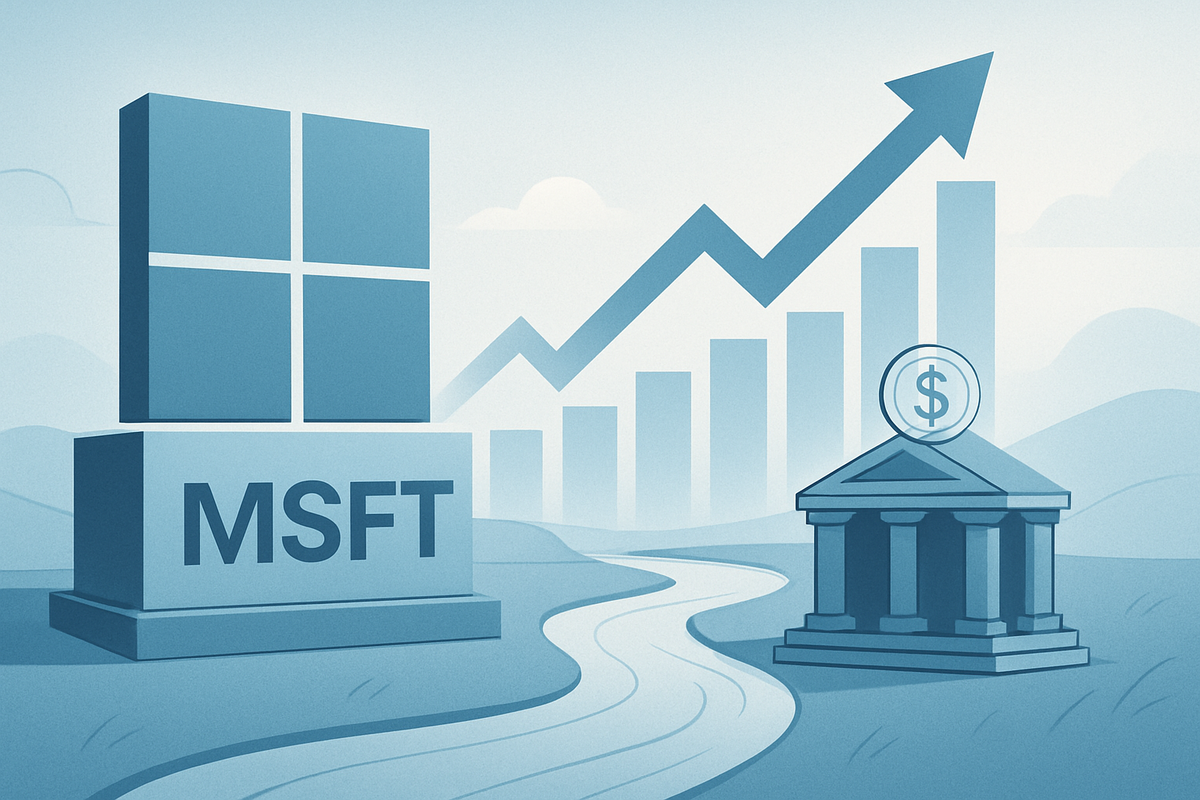
Redmond, WA – October 14, 2025 – Technology giant Microsoft Corporation (NASDAQ: MSFT) has once again affirmed its commitment to shareholder returns, with its most recent quarterly dividend declaration signaling continued financial strength and a reliable income stream for investors. As the market anticipates future declarations, the consistent growth and sustainable policy of Microsoft's dividend remain a key focus for income-oriented portfolios and a testament to the company's robust financial health.
The latest announcement, made on September 15, 2025, set the quarterly dividend at an impressive $0.91 per share. This declaration positions Microsoft as a stalwart in the dividend growth arena, reinforcing its appeal to a broad spectrum of investors looking for both capital appreciation and steady income in a dynamic market. The immediate implications are clear: continued confidence in Microsoft's earnings power and a potential draw for new investments ahead of the upcoming ex-dividend date.
Microsoft's Unwavering Commitment to Shareholder Returns
Microsoft's recent dividend declaration on September 15, 2025, for a $0.91 per share payout, underscores a deeply ingrained financial strategy focused on consistent shareholder value. The ex-dividend date for this payment is set for November 20, 2025, with shareholders receiving their distributions on December 11, 2025. This latest move extends a remarkable streak of dividend increases, marking 20 consecutive years of growing payouts—a rare feat for a technology company of its size and scope.
The timeline leading up to this moment reveals a predictable pattern of declarations, typically occurring in mid-September for the final quarter of the calendar year, followed by similar schedules for subsequent quarters. This predictability is a cornerstone of its attractiveness. Key players involved include Microsoft's board of directors, responsible for approving the dividend, and its executive leadership, whose strategic decisions drive the profitability necessary to sustain such payouts. Initial market reactions to these declarations are generally positive, often leading to increased investor interest as the ex-dividend date approaches, followed by the customary slight dip in share price on the ex-dividend date itself. The stability offered by such a consistent dividend payer, especially one operating at the forefront of technological innovation, tends to foster strong investor confidence.
Winners and Losers: The Dividend's Market Ripple
Microsoft's (NASDAQ: MSFT) robust and growing dividend policy primarily benefits its vast shareholder base, particularly income-focused investors, retirees, and institutional funds that prioritize stable returns. These investors win by receiving a consistent and increasing cash flow, which can be reinvested or used as income. The company's low payout ratio, typically between 23-25%, ensures the dividend's sustainability, providing a strong sense of security for long-term holders. This also allows Microsoft to retain significant capital for research and development, strategic acquisitions, and organic growth initiatives, further cementing its market leadership and future profitability.
Conversely, while there are no direct "losers" from a healthy dividend, companies with less stable or non-existent dividend policies in the tech sector might find themselves comparatively less attractive to a segment of the investor community. For instance, younger, high-growth tech firms that prioritize reinvestment over dividends, while offering higher growth potential, may not appeal to the same risk-averse, income-seeking investors drawn to Microsoft. This dynamic can subtly influence capital allocation across the market, potentially diverting some investment flows towards established dividend payers like Microsoft during periods of market uncertainty. Furthermore, investors who buy shares after the ex-dividend date will miss out on the declared payment, experiencing a slight price adjustment without the immediate income benefit.
Broader Significance: A Bellwether for Tech Maturity
Microsoft's sustained dividend growth and prudent payout policy carry broader significance, serving as a bellwether for the increasing maturity and financial stability within the technology sector. Historically, tech companies were known for reinvesting all earnings back into growth, often eschewing dividends. Microsoft, alongside a few other tech giants, has demonstrated that it's possible to maintain aggressive innovation while simultaneously rewarding shareholders with consistent income. This trend signals a shift in the industry, where established players are now viewed not just as growth engines but also as reliable income generators.
The ripple effects extend to competitors and partners. Other large-cap tech companies, such as Apple (NASDAQ: AAPL) and Cisco Systems (NASDAQ: CSCO), which also pay dividends, might feel pressure to maintain or grow their own payouts to remain competitive for income-seeking capital. For companies aspiring to similar market capitalization and stability, Microsoft's dividend strategy offers a blueprint for balancing growth and shareholder returns. Regulatory or policy implications are minimal, as dividend policies are primarily internal corporate decisions, but a strong, stable dividend can enhance a company's perception of financial responsibility and stability, which can be favorable in broader economic or regulatory discussions. Historically, consistent dividend growth from market leaders often signals a healthy economic environment and robust corporate earnings, offering a positive indicator for the overall market.
What Comes Next: Sustained Growth and Strategic Flexibility
Looking ahead, the short-term outlook for Microsoft's dividend policy points towards continued consistency and incremental growth. Given its 20-year track record and healthy payout ratio, investors can reasonably anticipate further modest increases in the quarterly dividend in the coming declarations. Long-term possibilities include the potential for accelerated dividend growth if Microsoft's already robust free cash flow continues to expand significantly, or conversely, a slight deceleration if major strategic investments or economic downturns necessitate capital preservation. However, the company's strong balance sheet and diverse revenue streams from cloud computing (Azure), productivity software (Office 365), and gaming (Xbox) provide substantial insulation against such risks.
Potential strategic pivots or adaptations required by Microsoft are unlikely to directly impact its core dividend policy unless there's a fundamental shift in its business model or a major economic shock. Instead, the dividend acts as a stable foundation, allowing management strategic flexibility to pursue growth opportunities without undermining investor confidence. Market opportunities may emerge for investors seeking a blend of growth and income, as Microsoft consistently offers both. Challenges could arise if competitive pressures intensify in its core markets, but its diversified portfolio mitigates this. Potential scenarios include continued market leadership with steady dividend growth, or in a less likely scenario, a more aggressive capital return strategy through share buybacks if the stock is deemed undervalued, though dividends are likely to remain a cornerstone.
Wrap-Up: A Dividend Darling in the Tech Landscape
Microsoft's (NASDAQ: MSFT) latest dividend declaration reaffirms its status as a premier dividend growth stock within the technology sector, offering a compelling blend of innovation and shareholder returns. The key takeaway is the company's unwavering commitment to its dividend, evidenced by two decades of consistent increases and a conservative payout ratio that ensures sustainability. This policy not only rewards loyal shareholders but also signals robust financial health and a confident outlook on future earnings.
Moving forward, the market will likely continue to view Microsoft as a reliable anchor in diversified portfolios, particularly for those seeking income stability in an often-volatile tech landscape. Investors should watch for future quarterly declarations, anticipating further incremental increases that align with the company's historical growth trajectory. Furthermore, monitoring Microsoft's continued performance in its cloud and enterprise segments will provide insights into the underlying profitability driving these dividends. The lasting impact of Microsoft's dividend strategy extends beyond its own shareholders, setting a benchmark for financial maturity within the tech industry and demonstrating that growth and income are not mutually exclusive for market leaders.
This content is intended for informational purposes only and is not financial advice






